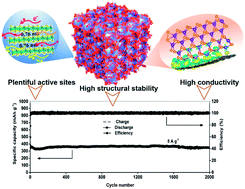Hierarchical nanoarchitectured hybrid electrodes based on ultrathin MoSe2 nanosheets on 3D ordered macroporous carbon frameworks for high-performance sodium-ion batteries†
Abstract
Sodium-ion batteries (SIBs) have been considered a promising alternative to lithium-ion batteries for large-scale stationary energy storage due to their low cost and the abundant resources of sodium. Nevertheless, the lack of anodes with high capacity and long-term cycling stability seriously hinders the commercialization of SIBs. Herein, ultrathin 2D MoSe2 nanosheets (∼2 nm) strongly bonded on 3D ordered macroporous (3DOM) carbon are designed to greatly improve sodium storage. The resulting MoSe2@C composite delivers high capacity (410 mA h g−1 at 0.5 A g−1 after 100 cycles, considering the total weight of the active MoSe2@C), superior rate capability (279 mA h g−1 at 10 A g−1), and long-term cycling stability (384 mA h g−1 at 5 A g−1 after 2000 cycles). The enhanced electrochemical performance can be ascribed to synergistic effects between the hybrid structures constructed from 2D MoSe2 nanosheets and the 3DOM carbon architecture, which can provide expanded interlayer spacing (0.76 nm for a single layer) facilitating Na+ insertion/extraction, strong electronic coupling of Mo–C boosting the fast electron/ion transfer, and ordered 3D cavities accommodating the volume expansion and preventing the stacking of MoSe2 nanosheets upon cycling.



 Please wait while we load your content...
Please wait while we load your content...